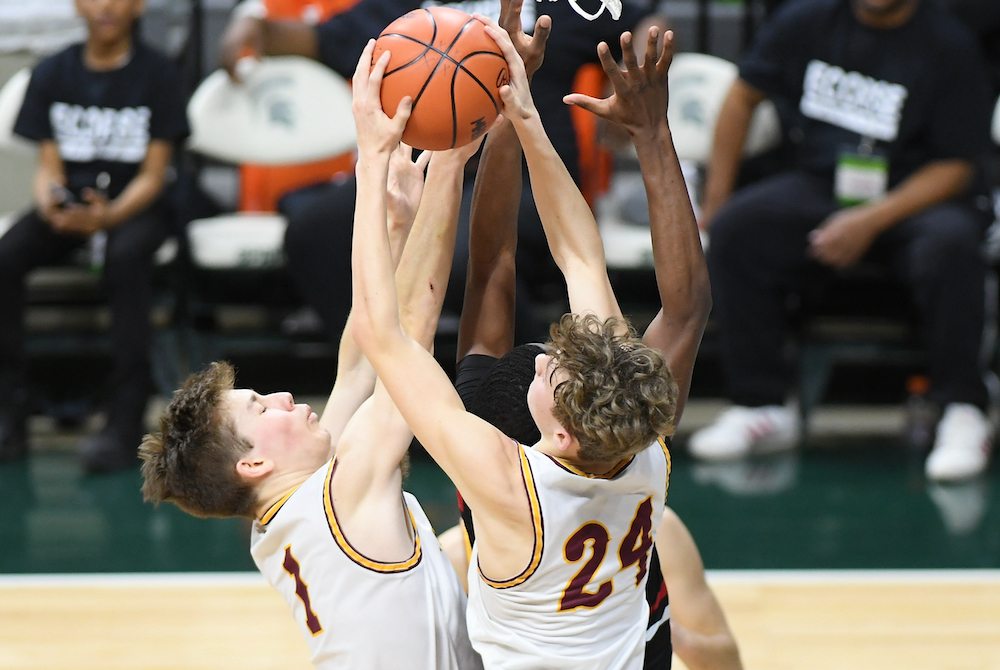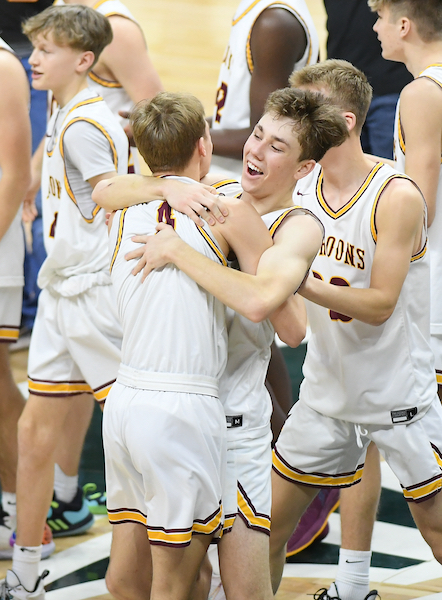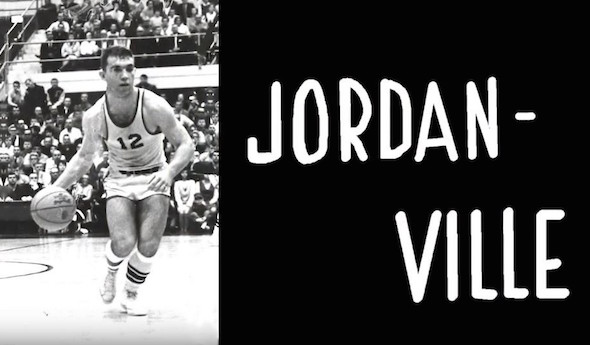
Menominee Extends Downstate Stay to Championship Day with 'Powerful' Performance
By
Keith Dunlap
Special for MHSAA.com
March 24, 2022
EAST LANSING - The chants from the Menominee student section said it all during the final minute of the first Division 3 Boys Basketball Semifinal on Thursday at Michigan State University’s Breslin Center.
“U.P. power! U.P power!”
Indeed, Menominee represented the Upper Peninsula loud and proud, taking a big early lead, withstanding a furious second-half rally, and then pulling away late for a 74-56 win over Ecorse.
Menominee advanced to its first MHSAA Finals championship game since it won the Class B crown in 1967.
“It’s kind of surreal,” said Menominee senior Brady Schultz.
It was a balanced effort for Menominee, led by Schultz, who had a game-high 26 points to go along with seven rebounds.
Senior Cooper Conway had 18 points and nine rebounds, senior Aidan Bellisle had 12 points and 10 assists and senior Brady Badker added 10 points for Menominee (23-3).
The Maroons showcased their ability to handle what a quick Ecorse team threw at them, displaying their length, ball movement and athleticism.
“That’s been something that’s been our trait and our characteristic all season long,” Menominee coach Sam Larson said. “We are fairly long, and we think we are pretty athletic. I know there is probably a difference in athleticism most times when the U.P. teams come down to play Lower Peninsula teams. But we think we match up athletically with most teams in the state in our division.”
Schultz said a game earlier in the season against Milwaukee Bradley Tech helped his team simulate the quickness and defensive pressure Ecorse offered.
“When we handle the pressure well, we get open shots and dump offs,” Schultz said. “Bradley Tech pretty much helped us with that game.”
Ecorse scored the first five points over the opening 1:34 of the game. But Menominee responded with a 12-0 run over the next three minutes and never looked back.
The Maroons held a 19-13 lead going into the second quarter, and with a 7-2 run took a 36-18 lead with 1:56 remaining until halftime.
 Menominee ended up taking a 41-23 lead into the locker room at the break, shooting 51.7 percent from the field overall (15 of 29) and making 7 of 14 shots from 3-point range.
Menominee ended up taking a 41-23 lead into the locker room at the break, shooting 51.7 percent from the field overall (15 of 29) and making 7 of 14 shots from 3-point range.
The Maroons also forced 12 turnovers during the first half.
Ecorse came out with more urgency in the second half, employing full-court pressure, hitting some shots and getting back in the game.
The Raiders scored almost as many points during the third quarter (22) as they did in the first half, cutting the Menominee lead to 53-45 entering the fourth quarter.
The lead continued to shrink, with Ecorse cutting the Menominee advantage to 57-52 with 6:11 remaining after a deep 3-pointer by junior Kenneth Morrast Jr.
“I thought we got tentative offensively,” Larson said. “We wanted to just pass it around and run the clock, and that’s not where we are at our best. If we get an open shot, we have to go after it.”
However, Menominee held firm for the next few minutes, keeping a 63-56 lead with 2:38 remaining before putting the game away.
Effectively breaking the Ecorse press, getting stops and making free throws, Menominee went on an 11-0 run, punctuated by a Schultz dunk, to take a 74-56 lead with just over 57 seconds remaining.
Ecorse (9-13), which had to forfeit 10 games during the regular season, was playing in its first Semifinal since 1980.
Morrast scored 20 points, and sophomore Dennell Kemp added 15 for the Raiders.
Ecorse coach Gerrod Abram said he was proud of how his team rallied from a big deficit in the first half, but his squad simply ran out of gas.
“We dug a hole for ourselves that we just couldn’t get out of,” Abram said. “But I’m just so very proud of my team and these young men here.”
PHOTOS (Top) Menominee’s Brady Schultz (24) gets his hands on a loose ball during Thursday’s Division 3 Semifinal win over Ecorse. (Middle) The Maroons celebrate advancing to the championship game. (Click for more from Hockey Weekly Action Photos.)

Film Fills In Picture of 'Fennville Flash'
By
Ron Pesch
MHSAA historian
December 28, 2017
We’ve been here before, but not in this way.
The last time was for a retrospective, covering one of the most impressive and awe-inspiring prep careers in Michigan high school history. That time was in print, and included a handful of still images that tried to illustrate the unbelievable.
But this time, the story is in documentary form. It’s woven together from grainy, scratched, faded silent film, a format of capturing memories familiar to thousands of people from generations past, as well as a series of modern-day high-resolution interviews.
Here, the basketball life of the athlete known as the “Fennville Flash” delivers on many levels. Yes, there is a Richie Jordan.
JordanVille, a documentary by John Mooy & Anne Colton, recalls a time when legend spread via word of mouth, newsprint and AM radio.
While it’s hard to comprehend for many today, the exploits of our athletic heroes were formed by “poets in the press box” who sat with pencil and paper, a typewriter, a microphone or a telephone, and described to their audience what they witnessed. On the receiving end, readers and listeners conjured up visualizations based on the facts, phrases and superlatives designed to create an image.
“Traveling left to right on your radio dial” helped listeners feel they were a member of the crowd, seated in the stands, in on the action and a witness to the mayhem. “Packed to the rafters,” reminded fans the importance of what was happening. An exciting game, presented by those with skill, created an event you longed to see. If a broadcast couldn’t be picked up on a transistor or tube radio, the final result might not be known, at the earliest, until the following day’s newspaper arrived.
I’ve told Jordan’s story via the MHSAA before; how he latched on to athletic training, weights and repetition to mold himself into a well-rounded athlete, able to leap to heights unexpected for a kid with a 5-foot-7 frame. The tales of his unfathomable accomplishments slowly leaked beyond the city limits of Fennville into Kalamazoo and greater Southwestern Michigan, then to Detroit. When Detroit Free Press writer Hal Schram relayed Jordan’s feats, the secret traveled across the state and beyond its drawn borders.
From there the legend of Jordan’s accomplishments grew. In Fennville, as in many small towns across the country, the city shut down when a game was played. The Jordan story was so enticing that thousands would travel vast distances to see him play with their own eyes. Today, his single season scoring average of 44.4 points per game during the 1964-65 campaign still remains the top mark in the MHSAA record book.
 JordanVille runs just shy of a half hour. Contained within is insight into the athlete that is challenging to relay in print form. Thanks to access to home movies and a series of interviews with Jordan, former teammates, past opponents and his high school coach, the determination, dedication and drive of a kid who wouldn’t let physical size be a deterrent from achievement radiates from the screen. On display is small town America at its finest, and perspective formed over 50+ years.
JordanVille runs just shy of a half hour. Contained within is insight into the athlete that is challenging to relay in print form. Thanks to access to home movies and a series of interviews with Jordan, former teammates, past opponents and his high school coach, the determination, dedication and drive of a kid who wouldn’t let physical size be a deterrent from achievement radiates from the screen. On display is small town America at its finest, and perspective formed over 50+ years.
For Mooy, it completes a filmmaking journey started six years ago. But the story of Jordan, in his eyes, date back to his school days. Mooy first heard about Jordan as a 7th-grader from a math teacher. A second-team all-St. Joseph Valley League selection, Mooy played at Marcellus High School and scrimmaged against Jordan and the Fennville Blackhawks.
He couldn’t believe his eyes.
“Everyone wanted to see this kid play,” said Mooy in 2011. “He was the first high school player I saw sign an autograph.
Today, with the interviews complete, and the film ready for viewing, Mooy sees more than just a sports story:
“With the benefit of years now passed, I look at the Rich Jordan story with a new respect. JordanVille created a place that was welcoming no matter who you were, or what color your skin happened to be. It was the 1960s. Rich was growing up Jewish, the Civil Rights Movement was in full swing, and the Vietnam War was on everyone's mind. And in Fennville, Michigan, from 1961 to 1965, the Jordan high school years, there were lessons beyond sports being learned by everyone that would last a lifetime. The Jordan household, under the guidance of (his parents) Tuffy and Sylvia Jordan, is where the story begins."
The film speaks of a time that has departed. Competition for our attention was less focused; phones hung on walls or sat on tabletops, communities were tighter, the training table featured peanut butter and chocolate milk instead of protein powder. A city could easily be renamed for a day.
The film also reminds us that those days were far from perfect.
If all goes as planned, the public will see the finished product come the flip of the calendar. In West Michigan, JordanVille is scheduled to show on New Year’s Day at 6 p.m. on WGVU, and will repeat on WGVU-Life at 7:30 p.m., Friday, Jan. 5.
Seek it out, and spread the word, just like in days of old.
 Ron Pesch has taken an active role in researching the history of MHSAA events since 1985 and began writing for MHSAA Finals programs in 1986, adding additional features and "flashbacks" in 1992. He inherited the title of MHSAA historian from the late Dick Kishpaugh following the 1993-94 school year, and resides in Muskegon. Contact him at [email protected] with ideas for historical articles.
Ron Pesch has taken an active role in researching the history of MHSAA events since 1985 and began writing for MHSAA Finals programs in 1986, adding additional features and "flashbacks" in 1992. He inherited the title of MHSAA historian from the late Dick Kishpaugh following the 1993-94 school year, and resides in Muskegon. Contact him at [email protected] with ideas for historical articles.
PHOTOS: (Top) Richie Jordan runs Fennville's offense during his thrilling high school career in the 1960s. (Middle) Jordan memorabilia, as captured by Bill Williams.

